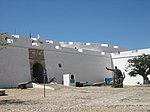Fortress of São Miguel
1576 establishments in the Portuguese EmpireBuildings and structures in LuandaForts in AngolaMunicipalities in LuandaPortuguese Angola ... and 1 more
Portuguese forts

Fortaleza de São Miguel or Saint Michael Fortress was a Portuguese fortress built in 1576 in the Ingombota District of Luanda, Angola. During Dutch rule in Angola between 1641 and 1648, the fort was known as Fort Aardenburgh.
Excerpt from the Wikipedia article Fortress of São Miguel (License: CC BY-SA 3.0, Authors, Images).Fortress of São Miguel
Avenida Agostinho Neto, Luanda Kinanga
Geographical coordinates (GPS) Address Nearby Places Show on map
Geographical coordinates (GPS)
| Latitude | Longitude |
|---|---|
| N -8.8083 ° | E 13.2234 ° |
Address
Avenida Agostinho Neto
Luanda, Kinanga
Luanda Province, Angola
Open on Google Maps








